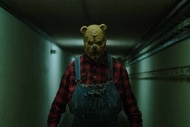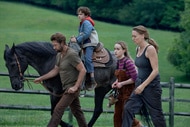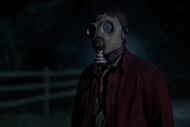Black Lightning's creator traces the rocky road to DC's first standalone black superhero

Black Lightning holds a special place in the history of DC Comics as the first African-American superhero to be featured in his own monthly title for the company.
From his humble beginnings as a solo defenders of Metropolis' Suicide Slums in the pages of his original 1977 ongoing series, to today where he features prominently across different media; in video games (Injustice 2), cartoons (Young Justice: Outsiders), and most prominently these days as the eponymous lead of his own CW series.
As is the case with any long-standing character in the DC pantheon, Jefferson Pierce, aka Black Lightning, has gone through quite the journey to become the character we know today. No one is better suited to comment on that journey than the writer who originally created Black Lightning, Tony Isabella.
SYFY WIRE spoke with Isabella on a variety of topics ranging from his four-decade relationship with Black Lightning to his contentious relationship with DC Comics over the years, culminating in his thoughts on the latest TV incarnation of the character and his relationship with the show going forward.
How did you get into writing comics?
I read comics all my young life, and it was in July of 1963, out at a very boring family vacation to a little place called Oneonta, New York, I bought Fantastic Four Annual #1, which is the greatest comic book ever made. Both because it's a great comic book and because it suddenly hit me that making comic books was a job, and I wanted that job.
I wasn't sure I could get that job, but from that point on, I used to train myself. I used to study comic books. trained myself to write scripts, I used to do amateur scripts with friends of mine, and my backup plan was to become a reporter. Clark Kent crusading reporter type.
Which you eventually followed through on, correct?
I went to work for The Plain Dealer [in Cleveland], which was a tool of the rich and the powerful.
Sounds like you weren't a fan of the paper. What caused you to make the jump away from newspaper work?
We went on strike. The owner of the paper called up his buddy the mayor of Cleveland and said, "Hey, you know these people in front of my building? Can you do something about it?" And our picket line was attacked by mounted policemen. I was knocked to the ground by a panicky copy editor. A horses hoof landed like inches from my face.
Wow.
Yeah. So I got up, went home and called Roy Thomas, who was the editor-in-chief at Marvel. Roy and I had become friends... I asked Roy if there was an entry-level job at Marvel, and it turned out there was. Marvel was publishing British weeklies, newsprint type comic books, magazine size, reprinting Marvel stories in the style of the actual British comics. And it was Stan Lee's baby and he needed an assistant. So in many regards, my first boss at Marvel was Stan Lee. So between Stan, Roy Thomas, Len Wein, Mark Wolfman, and Steve Gerber, I learned an awful lot about comics very quickly.
What were some other the other projects you were involved in during your stay at Marvel?
I was an editor at Marvel. I eventually went full-time freelance for them.
Now I need to give you some more background. I grew up in Cleveland, which was a very segregated city. My first black friends were three comic book fans who came from the east side of Cleveland [to the] west side of Cleveland to attend a comic book club that I started. I was 17, 18. Diversity wasn't really part of my language. But it just struck me as fundamentally unfair that there weren't more heroes of color for my black friends. I always told myself if I got into comics, I would [try] to work on characters of color as well as create characters of color.
When I got Marvel, it turns out I wrote Luke Cage for a while. Captain America and The Falcon. I wrote [N'Kantu,] the Living Mummy. Not that many people realize he was black because, you know, the mummy bit and all.
Who were some of the characters you created for Marvel?
I created Misty Knight while I was writing Iron Fist. And I took a supporting character, Bill Foster, who had worked with Hank Pym over on the Avengers and made him Black Goliath. I wasn't wild about the Black Goliath thing, but they wouldn't let me call him Giant-man because Giant-man had sold really badly, and so they didn't want to go near that name again.
Black Panther was a great character, but he was an African King. Luke Cage was a great character, but he was an ex-con, unjustly convicted or not. Steve Englehart — in one of the dumbest things he ever did — decided that the Falcon was really a criminal.
I was building towards a more positive black character and had I kept writing Luke Cage, I would have cleared him, and he would have actually gone back to school. With Black Goliath, [at] least I had a character who was a scientist and had the respect of other scientists. I was getting closer to what I wanted.
Why did you end up leaving Marvel?
Roy left [as Editor-in-Chief] and then Len Wein was Editor and he left, and Marv Wolfman was Editor and he was leaving. Gerry Conway was Editor for three weeks. The job evolved along the way and it was harder for the editors who followed Stan to deal with corporate than it had been for Stan.
At the same time, DC had gotten a new publisher, Jenette Kahn, and DC recruited me. They wanted me to come over there, and there were people at DC I wanted to work with. So I accepted their offer.
And mind you, DC Comics never kept a single agreement they made with me until very recently. So the DC experience wasn't as great as I would've liked... but it did give me and the world Black Lightning.
What happened when you initially arrived at DC?
When I went to DC in 1976, I was handed two scripts of something called the Black Bomber. These were scripts produced by Gerry Conway and Bob Kanigher — terrific writers, good guys. But the fact was these scripts were the most offensive scripts I'd ever read in my life.
The Black Bomber was a white racist who took part in camouflage experiments during the Vietnam war to help him blend into the jungle better.
I hate where this is going.
Save your hate, there's more to come.
So nothing happened when he was Vietnam. But when he was discharged home at various times, he would turn into a black superhero. The white racist didn't know that he turned into a black superhero. Likewise, the black superhero didn't know he was really a white racist.
[In] the worst of these two scripts, his white racist identity saves people who [he] can't see clearly and then is horrified when he learns he risked his life to save a black person, one being a child in a baby carriage. And when he finds out it's a black kid, he literally says, "You mean I risked my life for a jungle bunny?"
Wow.
The cherry on this s**t sundae was that his uniform was essentially a basketball uniform. So I told DC "no," I could not punch up these scripts and take over the book with the third issue because they were the most offensive things possible and if you put them out, people would come to their offices with pitchforks and torches.
They asked, "how could you possibly know this?" and I said, "Because I'll be leading them."
How long did your initial conversations about Black Bomber go on for with DC?
We argued about this for two weeks until I finally boiled it down to one question: "You really want DC's first headline black superhero to be a white racist?" And at that point, they agreed it was a bad idea. They killed the project and gave me basically two, three weeks to create a new black hero.
Which brings us to the creation of Jefferson Pierce.
Given the chance to create a new character, I thought really hard about what I wanted to do. I wanted a character that kids could relate to because kids were still our major market back then. And that's why he became a teacher because every kid knows what a teacher is.
I wanted a very positive character. I actually spent most of my creative time for Black Lightning creating Jefferson Pierce. I didn't come up with the Black Lightning identity until a couple of hours before the meeting where I pitched the character. Jefferson Pierce was always more important.
Tonally, what were you going for as you went into your first run with Black Lightning?
I wanted to tell street-level superhero stories. I wanted to show the mean streets. I even slipped in a subtle mention of teen prostitution. For the times, especially at DC, it was a more violent series than most.
So now that the character was established, you needed an artist. How did Trevor Von Eden help you with the visual development of the Black Lightning?
I wrote a full script, so I didn't really collaborate with Trevor on the stories. Now I had always wanted a black artist on the strip. I was just planning on stealing somebody from Marvel, like Ron Wilson or Keith Pollard or Arvell Jones. Trevor was a young kid thrown into the deep end of the pool. He got into the business because a friend took drawings, which Trevor had done on notebook paper, and sent them to DC. Jack C. Harris, who was the first editor of [Black Lightning] called Trevor in.
I think they gave him a couple of short mystery stories and then gave him Black Lightning. So much enthusiasm — and he just swam with it. I could have gotten a more polished artist, but it was hard to say no to Trevor's enthusiasm. We did 10 issues together and Trevor ended up doing other stuff for DC after that.
Trevor was the main designer of the costume, but there were many other hands involved. I came up with the lightning piping on the outfit and what I called the Captain America boots. Bob Rozakis came up with the afro mask, which is kinda corny now, but at the time nobody had ever done anything like that. Joe Orlando opened up Black Lightning's shirt to show more skin. He had this idea that young readers liked to see more skin. I didn't quite get the argument but Joe was very good to me, he was a good story man, so I wasn't gonna make a big deal over a little extra skin. It was the '70s, so it's not like you didn't see shirts like that at discos and at other places.
What happened next?
We had a deal in place, unfortunately not in writing where it was supposed to be a 50/50 property split with neither side being able to do anything with the character without the other's approval. I left the book because DC had allowed Hanna-Barbera [to] steal Black Lightning and rename him.
This would be when the Super Friends introduced the character Black Vulcan?
I was under the impression Black Lightning was going to be in the Super Friends up until the moment I actually watched the show because I had been told by DC that he was going to be in [it].
What happened in DC's deal with me, let's say there were 10 DC characters in that cartoon. I would have been entitled to 10 percent or 20 percent of one 10th of what DC got from the show for my character. DC didn't want to pay that out of their cut, which is what they were supposed to do. So they told Hanna Barbera that they'd have to pay extra to use Black Lightning.
Hanna-Barbera, which was kind of cheap, essentially said, "no, we'll just steal the character." And they did.
So at that point, I quit DC. But my last script had someone named Barbara Hannah, who was a con woman going around the country with a phony Black Lightning. I was amazed that DC published that story.
Eventually, you found your way back to Jefferson Pierce as you launched another Black Lightning ongoing series in 1995.
Dick Giordano, who became [Vice President and Executive Editor], wanted me to write for DC again and basically asked me to write the one thing I could not refuse, which was Black Lightning.
It was a process in recreating Black Lightning because I was determined not to write him exactly as I had written him before. [I wanted a] grittier, more realistic series. And I spent a year in the inner cities of Cleveland, working with schools, with churches, with police officers. I tutored gang kids. I mean, I really immersed myself as much in that community as a white guy could with the hope of being able to portray it accurately.
I discovered artist Eddy Newell at a convention. He had exactly the style I was looking for. In fact, even though Eddy worked from full scripts, the look of the comic was really all his. I did not give him a lot of strong physical directions for characters or setting because Eddy just nailed the look I wanted.
Eddie and I did eight issues together [of the total 13-issue run of this second series]. Then, once again, DC screwed me over.
They brought in an editor who wanted to replace me with somebody from Australia or something. I was fired and the reason given was I was fired for being late. It was nearly two months before the first issue of the second series had come out and I had already turned in the script for #9, which I had take my name off of because he had his scab writer rewrite it and take all the guts out of it. It was not a good script when it was done. So that script has the name Lane Shiro, which if you screw around with the letters, that comes out to Slain Hero.
Then I figured I was done with DC. By then I was screwed over by DC so many different ways. I can't even go into it.
So what happened to bring us to your current relationship with the company?
It's about 2016. There's new management at DC and Geoff Johns is running the movies and TV part of the company. Johns, who's a terrific writer and an even better human being, calls me up. They want to do a Black Lightning TV series, but they don't want to do it If I'm going to be unhappy. And that started a process.
I gave him my side of the story. What I told them was the absolute truth and it checked out. So we started working towards an agreement, so I do have an agreement in writing.
After that first conversation with Geoff, I knew I'd be working with DC again. The first thing they asked of me was to write a core values paper putting out who Black Lightning was, what he was about. Not as detailed as a show bible, more a value statement. I spent hours on the phone with [Executive Producers] Salim and Mara Brock Akil, who are brilliant, answering questions about Black Lightning, discussing stuff before the writers really geared up to start writing the scripts.
So you were deeply involved with the development of the show from the ground floor.
Salim flew me out to Burbank and I spent a day with the writers, which was just amazing. On one side of the writers' room, there was a whiteboard that had broken down the first season very roughly into 13 episodes. And there was a lot of me on that board. And then on the other side of the room was another big board. It had pictures of characters and names of characters and half of them were characters I created. I spent six hours talking to the writers about Black Lightning, answering questions about stories I've written 40 and 20 years earlier, kicking around ideas.
The end result being that while the writers and the actors and the directors have brought amazing new things to the Black Lightning TV show, there remains an awful lot of Tony Isabella in that show and everyone on that show has treated me with the greatest love and respect. They've become like family to me. I correspond with several cast members. On set, I saw China [Ann Mclain] in her Lightning costume. When she saw me, she literally squealed and ran over and hugged me. I talk to Cress Williams. Spent a lot of time with Marvin Jones, who is just the dearest guy.
What are some other high points of your time being involved with the show?
I was at the premiere in Washington D.C. early last year. I visited the set during the last week of shooting for the second season. I was at the wrap party where they asked me to speak to literally hundreds of good, creative, hardworking people who have jobs because of stuff I created 40 years ago.
































